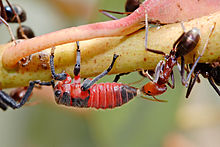Nymph (biology)
This article needs additional citations for verification. (December 2009) |


In biology, a nymph is the immature form of some invertebrates, particularly insects, which undergoes gradual metamorphosis (hemimetabolism) before reaching its adult stage.[1] Unlike a typical larva, a nymph's overall form already resembles that of the adult. In addition, while a nymph moults it never enters a pupal stage. Instead, the final moult results in an adult insect.[2] Nymphs undergo multiple stages of development called instars.
This is the case, for example, in Orthoptera (crickets and grasshoppers), Hemiptera (cicadas, shield bugs, etc.), mayflies, termites, cockroaches, mantises, stoneflies and Odonata (dragonflies and damselflies).[3]
Nymphs of aquatic insects, as in the Odonata, Ephemeroptera, and Plecoptera, are also called naiads, an Ancient Greek name for mythological water nymphs. In older literature, these were sometimes referred to as the heterometabolous insects, as their adult and immature stages live in different environments (terrestrial vs. aquatic).[citation needed]
In fly fishing with artificial flies, this stage of aquatic insects is the basis for an entire series of representative patterns for trout.[4] They account for over half of the over all patterns regularly fished in the United States.
See also
- Egg (biology)
- Naiads in Greek mythology
References
- ^ Encyclopedia of Entomology Ed. John L. Capinera. Dordrecht, London, Springer. 2008, 2nd Ed. ISBN 978-1-4020-6242-1 (Print) 978-1-4020-6359-6 (Online)
- ^ Truman, James (1999). The origins of insect metamorphosis. Washington: Macmillan Magazines Ltd. p. 447.
- ^ Britton, David (9 July 2009). "Metamorphosis: a remarkable change". Australian Museum. Retrieved 13 July 2015.
- ^ Austin, Matthew (2004). "Nymph patterns of flies". San Diego: theflystop.com.
